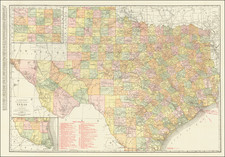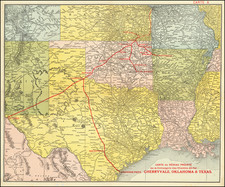18th-century Map of Eastern North America with a Satirical Cartouche
A finely colored example of Seutter's so-called Mississippi Bubble map, depicting the short-lived French financial-colonial scheme masterminded by Scottish financier John Law. The map shows a detailed treatment of much of North America focusing on the Mississippi River and the Great Lakes. A large inset of the Gulf Coast shows many forts and American Indian villages.
Perhaps the most interesting feature of the map is the elaborate title cartouche. It depicts an allegorical, satirical scene of the infamous Mississippi Bubble investment scheme with a female personification of the Mississippi River pouring jewels and riches forth, while she is perched precariously upon a bubble. Cherubs above the cartouche are issuing stock for the company, and another group is blowing bubbles in the foreground surrounded by piles of worthless stocks. In the background, desperate investors climb a small tree and fling themselves out of it, and in the foreground more disconsolate investors wail and bemoan their fates as one tries to impale himself on his sword. Above them, a cherub upends an empty money-bag.
The Mississippi Bubble Scheme
The Mississippi Bubble centered around John Law's Mississippi Company, a French trading company. The Mississippi Bubble occurred from August 1719 to May 1720, growing out of France's terrible economic situation in the early 18th century. When Louis XIV died in 1715, the French Treasury was a disaster, with the price of metal coins fluctuating wildly. The French regent turned to a Scotsman, John Law, for assistance. Law was a gambler who had exiled himself to France in order to avoid a duel. He suggested that the Banque Royale take deposits and issue bank-notes that would be payable in the value of the currency when the notes were issued. His ideas helped France make the transition from metal-based currency to paper currency, which resulted in a brief period of financial stability.
In August 1717, Law formed the Companie des Indes (commonly called the Mississippi Company), which received a monopoly on trading rights with the French colonies in the Americas (the Louisiana territory). By August 1719, Law had created a scheme that would let the Mississippi Company take on the entire French national debt. Portions of the debt would be exchanged for shares in the company. Law promised a 120 percent profit for shareholders. Not surprisingly, 300,000 would-be shareholders vied for the 50,000 shares that were being offered. As demand for the shares soared, the French government, which was effectively controlled by Law, continued to print paper banknotes, which caused inflation to skyrocket.
The bubble burst in May 1720 when a run on the Banque Royale forced the government to admit that the amount of metal-based currency in France was not equal to half the amount of paper currency that was circulating. The government issued an order that would gradually depreciate Mississippi Company shares, so that by the end of the year they would be valued at half of their nominal worth. That order was reversed a week later due to extreme public outcry, but the Banque Royale closed. It reopened in June, and the bank runs continued. By November 1720, the Mississippi Company shares were worthless and Law was forced to flee the country.
Matthäus Seutter (1678-1757) was a prominent German mapmaker in the mid-eighteenth century. Initially apprenticed to a brewer, he trained as an engraver under Johann Baptist Homann in Nuremburg before setting up shop in his native Augsburg. In 1727 he was granted the title Imperial Geographer. His most famous work is Atlas Novus Sive Tabulae Geographicae, published in two volumes ca. 1730, although the majority of his maps are based on earlier work by other cartographers like the Homanns, Delisles, and de Fer.
Alternative spellings: Matthias Seutter, Mathaus Seutter, Matthaeus Seutter, Mattheus Seutter









![[Restricted] New Orleans (0-6)](https://storage.googleapis.com/raremaps/img/small/68648.jpg)
![[ Oil & Gas in Texas and Louisiana ] Gulf Coastal Region Texas and Louisiana Showing Oil, Gas & Sulphur Fields & Prospects Pipe Lines & Refineries](https://storage.googleapis.com/raremaps/img/small/101409.jpg)

![Nord-Amerika [North America]](https://storage.googleapis.com/raremaps/img/small/91328.jpg)

![[First State of the Popple Key Sheet] A Map of the British Empire in America with the French and Spanish Settlements adjacent thereto by Hen. Popple.](https://storage.googleapis.com/raremaps/img/small/92714.jpg)